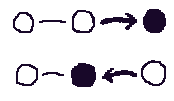Go Back One Step
Examples:
-
The "Back" button on a Web browser
-
The "Back" button on a wizard
-
Turning back a page in a physical book or magazine
-
The "Undo" feature on some computer applications
Context: The artifact allows a user to move through
spaces (as in Navigable Spaces), or
steps (as in Step-by-Step Instructions),
or a linear Narrative, or discrete states.
Problem: How can the artifact make navigation
easy, convenient, and psychologically safe for the user?
Forces:
-
Users tend to explore a navigable artifact in a tree-like fashion, going
down paths that look interesting, then back up out of them, then down another
path.
-
The user may want to temporarily look back at the previous space or state
they were in.
-
If the user gets into a space or a state that they don't want to be in,
they will want to get out of it in a safe and predictable way.
-
The user is more likely to explore an artifact if they are assured that
they can easily get out of an undesired state or space; that assurance
engenders a feeling of security.
Solution: Provide a way to step backwards to the
previous space or state. If possible, let the user step backwards
multiple times in a row, thus allowing them to backtrack as far as they
want.

Resulting Context: Having a "back" function implies
having a "forward" function; it's more of a convenience than a distinct
pattern, but Web browsers have set up this expectation, so your users may
be unpleasantly surprised if it's not there. Also, Go
Back to a Safe Place is a logical pattern to use in addition to this
one.
If the user knows they can step backwards multiple times, they may then
expect that they can see the history through which they are backtracking
-- in other words, their Interaction
History.
Notes: A 1994 paper on the usage of Web browsers
discovered that on average, the use of the "Back" button accounted
for 40% of a user's actions. This was second only to following an
actual link, which made up 52%. (In contrast, the "Forward" button only
accounted for 2%.) Reference: "Characterizing
Browsing Strategies in the World-Wide Web," by Lara D. Catledge and
James E. Pitkow.
Comments to: jtidwell@alum.mit.edu
Last modified May 17, 1999
Copyright (c) 1999 by Jenifer Tidwell. All rights reserved.

